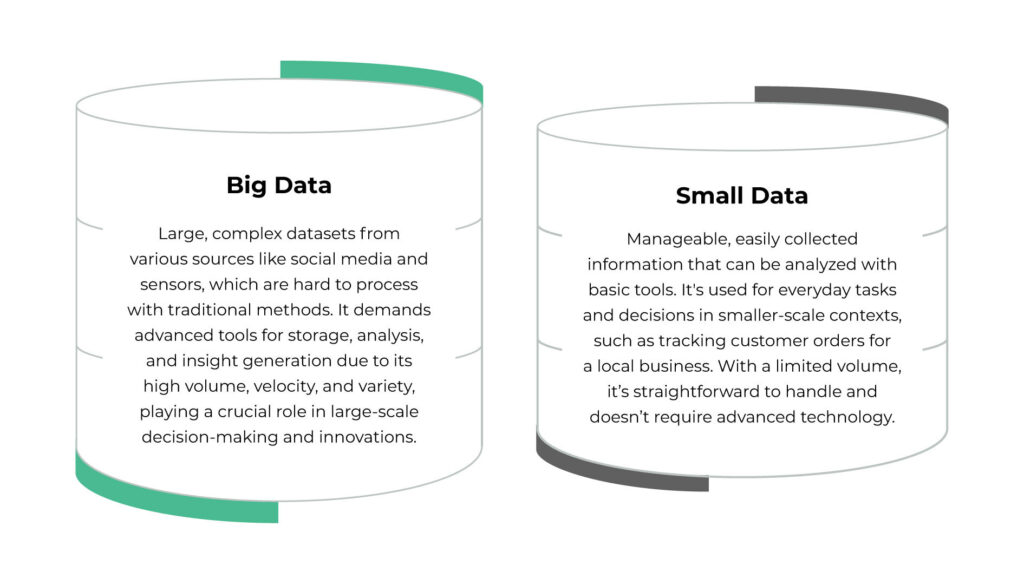Discover the untapped potential of small data and how it can drive significant results for your business.
In our data-obsessed world, the spotlight often shines on the colossal, the complex – big data. Its promise of uncovering hidden patterns and predicting future trends is undeniable. Yet, amidst the fervor surrounding this behemoth, a smaller, often overlooked dataset is quietly revolutionizing how businesses operate.
Small data, characterized by its manageability and human-centric nature, is emerging as a powerful tool for driving informed decisions. Unlike its larger counterpart, small data focuses on specific, actionable insights that can be readily understood and applied. It’s the data that resides within your organization, waiting to be transformed into a strategic advantage.
Let’s explore how this unassuming dataset can be a game-changer for businesses of all sizes.
What is Small Data?
Unlike big data, which encompasses vast, complex datasets requiring sophisticated tools for analysis, small data is manageable, human-comprehensible information derived from specific sources within an organization. It’s the data that’s right in front of you, waiting to be harnessed for actionable insights.
For instance, customer feedback forms, sales figures for a particular product line, or social media engagement metrics are all examples of small data. While it may seem less glamorous than the grand promises of big data, small data often holds the key to solving immediate business challenges.

Wide Data: A Middle Ground
To complete the picture, it’s essential to introduce the concept of wide data. Falling somewhere between small and big data, wide data combines diverse data types from various sources, offering a broader perspective than small data but without the overwhelming scale of big data.
Think of wide data as a zoomed-out view of your business, providing a more comprehensive understanding of your market and customers. While it doesn’t delve into the granular details of small data, it offers valuable context for decision-making.
The Power of Small and Wide Data
Both small and wide data offer significant benefits for businesses
- Enhanced Decision-Making: Small data provides specific, actionable insights that can be applied to address immediate challenges. Wide data, on the other hand, offers a broader context for making informed strategic decisions.
- Cost-Effective: Compared to big data initiatives, which often require substantial investments in technology and expertise, small and wide data are relatively inexpensive to manage.
- Real-Time Insights: Small and wide data can be processed and analyzed quickly, enabling businesses to respond to changing market conditions in real-time.
- Focus on the Human Element: Small data, in particular, emphasizes the human aspect of business, helping organizations understand customer needs and preferences on a deeper level.
Why Shift Focus to Small and Wide Data?
As businesses grapple with the increasing volume and complexity of big data, many are realizing the value of smaller, more manageable datasets. Here’s why
- Personalization: Small data allows for highly personalized customer experiences by providing insights into individual preferences and behaviors.
- Agility: Small and wide data can be analyzed and acted upon quickly, giving businesses a competitive edge in fast-paced markets.
- Efficiency: By focusing on relevant data, organizations can avoid the time and resources wasted on analyzing irrelevant information.
- Human-Centric Approach: Small data helps businesses stay grounded in the human element, ensuring that technology serves people, not the other way around.
Small Data: Real-World Applications
Let’s delve into specific examples of how small data is making a significant impact across various industries
Finance
Fraud Detection: Analyzing transaction data can identify unusual patterns that may indicate fraudulent activity.
Customer Segmentation: Identifying customer segments based on spending habits and demographics can help tailor financial products and services.
Risk Assessment: Analyzing loan application data can help assess creditworthiness and identify potential risks.
Retail
Inventory Management: Tracking sales of specific products can help retailers optimize stock levels, preventing overstocking or stockouts.
Customer Behavior: Analyzing point-of-sale data can reveal buying patterns, preferences, and purchase frequency, enabling tailored marketing campaigns and product recommendations.
Customer Feedback: Collecting and analyzing customer feedback through surveys or reviews can identify pain points and areas for improvement.
Healthcare
Patient Outcomes: Tracking patient data such as medical history, treatment plans, and outcomes can help identify effective treatment protocols.
Medication Adherence: Analyzing patient prescription refill data can help identify patients who may need additional support to adhere to their medication regimen.
Patient Satisfaction: Collecting patient feedback can improve patient experiences and identify areas for improvement in healthcare delivery.
Marketing
Email Marketing: Analyzing open rates, click-through rates, and conversion rates for email campaigns can optimize messaging and targeting.
Social Media Engagement: Monitoring social media metrics such as likes, shares, and comments can help gauge campaign effectiveness and identify influencers.
Customer Segmentation: Analyzing customer purchase history and demographics can create targeted marketing campaigns and personalized offers.
Manufacturing
Quality Control: Tracking production data can identify defects and process improvements.
Predictive Maintenance: Analyzing equipment performance data can predict when maintenance is needed, preventing costly breakdowns.
Supply Chain Optimization: Analyzing supplier performance data can identify bottlenecks and optimize the supply chain.
Unleash the Power of Small Data
In a world inundated with massive datasets, small data emerges as a quiet yet potent force. Its ability to provide actionable insights, coupled with its ease of management, makes it an invaluable asset for businesses seeking to make informed decisions. By focusing on specific, relevant data, organizations can unlock hidden opportunities, enhance customer experiences, and ultimately drive growth.
It’s time to shift our perspective and recognize the power of small data. By embracing this underutilized resource, businesses can gain a competitive edge and thrive in today’s data-driven landscape.
Ready to harness the potential of small data for your business?
CONTACT US to explore how we can help you turn your data into actionable insights. Let’s unlock the power of small together.
